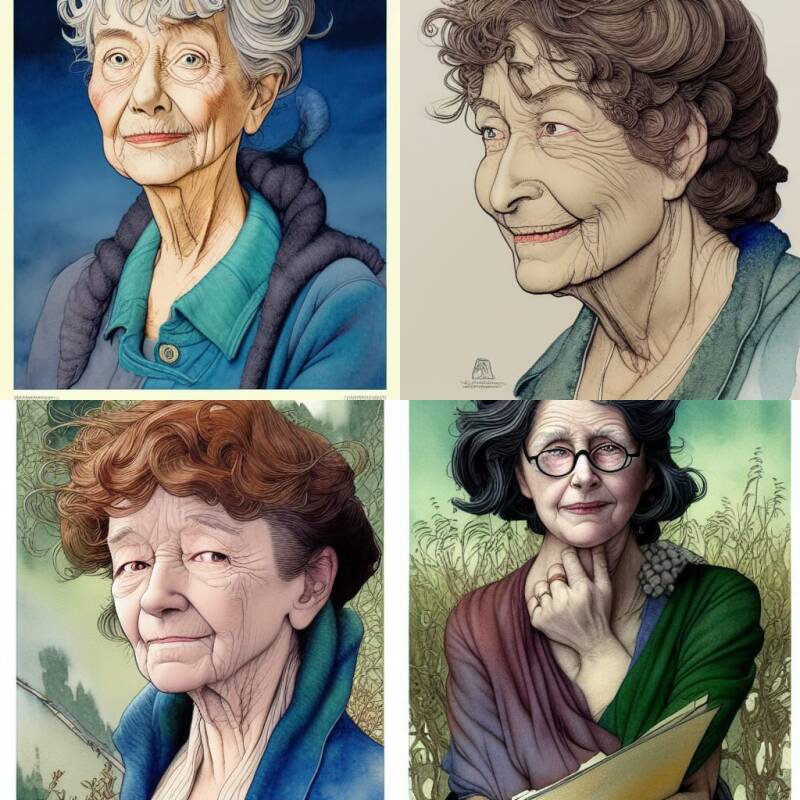Continue with my grannies
To pick up the thread of my previous blog: I have continued making portraits of inspiring older faces. These ladies here were generated in Stable Diffusion version 1.5 with the text:
'Grandma Anne, head and shoulders portrait, in brilliant watercolors, by Mark Brooks and Dan Mumford, by Hergé, by Arthur Rackham, Studio Ghibli, Anime Key Visual, perfect, smooth Epic cinematic brilliant stunning intricate meticulously detailed dramatic atmospheric maximalist, Deep Color, Intricate, Natural Lighting, Beautiful Composition'
These portraits are not perfect. Most have unwanted white borders and the AI often leaves just the top of the head off, but other than that these are beautifully lined faces of four really different grandmothers. A few more small mistakes: an AI-generated (fake) signature at grandma top right, a protrusion on the collar of grandma top left, and an arm that disappears into nothingness on grandma bottom right.
Analysis
It's funny how much influence just one word in the prompt can have. Before, I had tried almost the same prompt, but with 'old Anne' instead of 'grandma Anne'. Apparently, when thinking of 'old Anne', the AI thought more of 'the Anne from before, when she was still young', than of an Anne who is old.
This is an example of how to search for the right words to be properly understood. We can further analyze the prompt for its parts. Usually you start with what you want to see, and how you want to see it. Then what to paint with. Then name the style you want to use.
what = 'grandma Anne'
how = 'head and shoulders portrait'
with what = 'in brilliant watercolors'
The latter means you want an aquarel. I only found out later that I could have saved a lot of words here by just writing 'aquarel', but like everyone else I started by copying examples.
style = the rest of the text, where you may not exceed sixty words with this generator; the commas between the words count as words too (total 44 + 13 = 57).
Style
The style itself can also be frayed further apart. First, two of my favorite illustrators in whose style I would like to see my creations: 'by Hergé, by Arthur Rackham'. After that, a number of styles have been pasted together from the 25 presets that NightCafe Studio offers for all AI under its hood. Here, because of the limitation on the number of words, I have selected what seemed best to me.
Anime style: Studio Ghibli, Anime Key Visual, by Makoto Shinkai, Deep Color, Intricate, 8k resolution concept art, Natural Lighting, Beautiful Composition
Comic book style: Mark Brooks and Dan Mumford, comic book art, perfect, smooth
Epic style: Epic cinematic brilliant stunning intricate meticulously detailed dramatic atmospheric maximalist digital matte painting

The effect of each word can sometimes be guessed, but it often makes sense to play with the prompts for a while to get exactly the style and atmosphere you're looking for. A complicating factor is, that the 'what' and the 'how' also influence the execution of the style. If the artists whose style you want to work in, have never made a similar creation, the AI tends to revert to more photographic examples. You can see this in the following creations with grandmothers that fall outside the usual material of this style. Whereas 'old Anne' was already drawn in a more 'comic style' than 'grandma Anne', this 'more photographic' effect seems to become even stronger when we try to create grannies from distant regions.

In the meantime, additional options have been added to the Nightcafe Studio platform. First, a number of prompts of up to 60 words can now be specified per creation, and each prompt can be assigned its own weight. In addition, it is now also possible to specify negative weights. This makes it possible to ask for 'dress' with weight -1 instead of 'without dress' when you want to create a girl in trousers. Or "borderless, signatureless, not out of frame" and everything else that should not go wrong when generating these creations, can be rewritten with a negative weight.

Editing
There are a number of options to get rid of the cosmetic flaws:
The first and simplest option is to try the creation again. The original picture can be given as input, or only the value of the 'seed' (a random number that is part of the input) can be slightly changed, while the text remains unchanged.
A second option is 'inpainting'. The flawed image is given as input, but the wrong parts are marked and the text prompt is adjusted to describe what should now be drawn in those places.

A third option is 'outpainting', which is especially important if something important needs to be added outside the frame. For this you either have to go to another provider of AI art, or you download the image to your computer, put it in a larger image surrounded by noise, then use this new image as a starting image as with 'inpainting'.
The fourth - and actually the most fun - option is to edit the image yourself in a program like Photoshop or Krita. You keep full control over the result and the adjustments, but it does depend on your own skills as a photo editor and painter.
I'm going to do the latter with some of the images above. I'm already excited.



Reactie plaatsen
Reacties